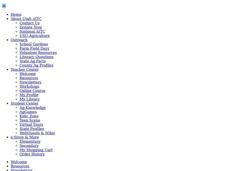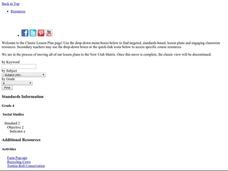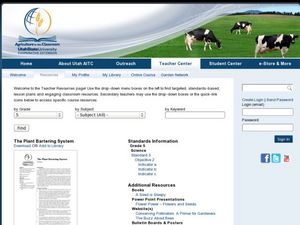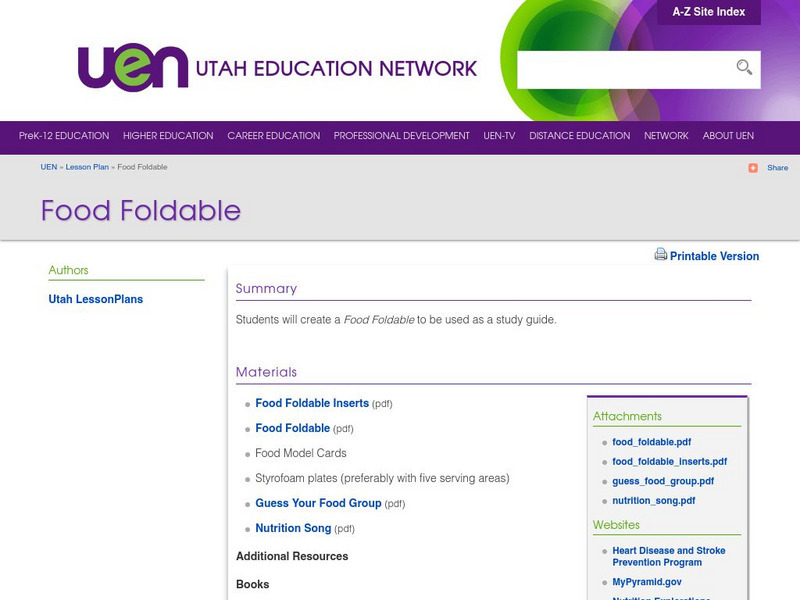Curated OER
Parents Are People Too
In this social studies family dynamics worksheet, students complete a two sided chart. On one side, students list things that their parents do that they like. The other side is to list the things parents do that they do not like. There...
Curated OER
Food Travels and Preservation
Fourth graders study food processing and distribution. In this food processing lesson, 4th graders investigate various methods of food preservation. Students study methods of food distribution.
Curated OER
Baa, Ram, Ewe.... Sheep Tales
Pupils explore animal characteristics by reading animal stories in class. In this sheep habitat lesson, students identify the uses for sheep in our agricultural based society and the importance of wool in our economy. Pupils read several...
Curated OER
How Does Your Garden Grow?
Students explore plant life by reading books about gardening. For this botany lesson, students read the books From Seed to Plant and Oh Say Can You Seed? while identifying the necessary elements to raising a healthy plant. Students view...
Curated OER
Where is Agriculture?
Students study agriculture. In this agriculture lesson plan, students investigate how agriculture helps to meet a family's needs. Students identify things in their home that began as agriculture.
Curated OER
My Little Seed House
First graders chart the growth and development of seeds. In this seed growth lesson, 1st graders observe seeds as they mature through the growing process.
Curated OER
Plant Growth
First graders investigate how seeds are moved and how plants grow. In this plant growth instructional activity, 1st graders listen to stories, play a game, and view a PowerPoint about plant growth. Students examine various seeds...
Curated OER
Color in the Garden
Third graders study color in a garden environment. In this color lesson, 3rd graders explore the colors of living and nonliving elements within a garden environment. Resources are provided.
Curated OER
Cricket Wars
Third graders explore living and nonliving things in a garden environment. In this garden environment lesson, 3rd graders study the effects of crickets in a garden. Students explore the interaction between living and nonliving elements.
Curated OER
Vermicomposting
Third graders study vermicomposting. In this vermicomposting lesson, 3rd graders prepare to begin a unit on decomposition by constructing a worm bin. Students collect worms to be used later in experiments.
Curated OER
My Farm Web
Third graders explore agriculture by viewing video clips in class. In this farm animal lesson, 3rd graders identify the animals mostly eaten that come from farms and the types of food they consume before they are eaten by us. Students...
Curated OER
Powerful Potato
Third graders recognize the importance of geography in shaping a settlement where people can live. In this community location lesson, 3rd graders participate in a potato growing activity to understand how it helped a community...
Curated OER
Ride the Wild Leaf Cycle
Fourth graders explore plant life by completing an Internet activity. In this botany lesson, 4th graders identify the types of plants that grow locally and the different soils they utilize to survive. Students read assigned text about...
Curated OER
Water Supply
Fourth graders explore weather patterns by completing an Internet project. In this water cycle lesson, 4th graders read assigned text including a Magic School Bus book about precipitation and water. Students complete a water science...
Curated OER
Capital for Cookies
Fourth graders examine the history of Utah's economy. In this Social Studies lesson, 4th graders analyze producers and consumers role in the community. Students study Utah's economy throughout history.
Curated OER
Making a Brand for Ourselves the "Cowboy" Way
Fourth graders research the history of Utah. Students explore westward expansion and the importance of ranching in Utah's history. Students also investigate cattle drives in Utah.
Curated OER
The Plant Bartering System
Fifth graders explore plant characteristics by viewing a flower and seed presentation. In this environmental adaptation lesson, 5th graders identify specific traits plants have in order to allow them to grow in different climates whether...
Curated OER
Apple Science
Sixth graders explore agriculture by viewing a fruits and vegetables video clip. In this apple characteristics activity, 6th graders discuss how fruits and vegetables deteriorate after being exposed to oxygen and identify methods to...
Curated OER
A Common Thread
Sixth graders explore the Renaissance. In this Renaissance lesson, 6th graders study the culture and society of the middle ages. Students research the geography and climate of the times and discover how these affected agriculture.
Curated OER
European Agriculture
Sixth graders explore differences between European agriculture and American agriculture. In this agriculture lesson, 6th graders investigate the role that cultural differences play in agriculture and how these cultural differences affect...
Children's Museum
The Children's Museum of Indianapolis: Health House: Food, Fitness and Fun: 24/7
Engage your students in what it means to live a healthy life. They'll learn how to read food labels and understand basic nutrition. They'll take part in fun active play and learn about exercise benefits. Learn why healthy habits such as...
PBS
Pbs Learning Media: Curriculum Introduction: In Defense of Food
This section includes an overview of the curriculum, ideas for how to get started, and snapshots of the curriculum's key features. The "How to use this curriculum" section helps educators see how lessons are structured to be clear and...
National Institutes of Health
Nih Curriculum Supplement Series: The Science of Energy Balance
A great resource for teachers to help explain the balance between calorie intake and physical activity. There are many student activities that reinforce the need for physical activity in a healthy life style. Included are a teacher's...
Utah Education Network
Uen: Food Foldable
During this instructional activity, learners will listen to a poem about a balanced diet and create a foldable. In each section of the foldable, students will include information about a different food group and will use this creation as...





















